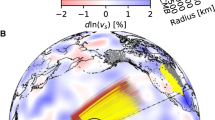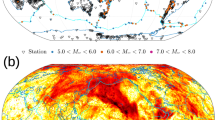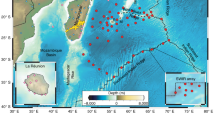Abstract
THE transition zone between the Earth's core and mantle plays an important role as a boundary layer for mantle and core convection1. This zone conducts a large amount of heat from the core to the mantle, and contains at least one thermal boundary layer2,3; the proximity of reactive silicates and molten iron leads to the possibility of zones of intermediate composition4. Here we investigate one region of the core–mantle boundary using seismic waves that are converted from shear to compressional waves by reflection at the boundary. The use of this phase (known as ScP), the large number of receiving stations, and the large aperture of our array all provide higher resolution than has previously been possible5–7. For the 350-km-long section of the core–mantle boundary under the northeast Pacific sampled by the reflections, the local boundary topography has an amplitude of less than 500 m, no sharp radial gradients exist in the 400 km above the boundary, and the mantle-to-core transition occurs over less than 1 km. The simplicity of the structure near and above the core–mantle boundary argues against chemical heterogeneity at the base of the mantle in this location.
This is a preview of subscription content, access via your institution
Access options
Subscribe to this journal
Receive 51 print issues and online access
$199.00 per year
only $3.90 per issue
Buy this article
- Purchase on Springer Link
- Instant access to full article PDF
Prices may be subject to local taxes which are calculated during checkout
Similar content being viewed by others
References
Lay, T. Eos 70, 54–55; 58–59 (1989).
Jeanloz, R. & Richter, F. M. J. geophys. Res. 84, 5497–5504 (1979).
Williams, O. & Jeanloz, R. J. geophys. Res. 95, 19299–19310 (1990).
Knittle, E. & Jeanloz, R. Geophys. Res. Lett. 16, 609–612 (1989).
Kanamori, H. J. geophys. Res. 72, 559–572 (1967).
Niazi, M. & McLaughlin, K. L. J. Geodynam. 8, 1–16 (1987).
Chowdhury, D. K. & Frasier, C. W. J. geophys. Res. 78, 6021–6028 (1973).
Vidale, J. E. & Benz, H. M. Nature 356, 678–683 (1992).
Burdick, L. J. Geophys. Jl R. astr. Soc. 80, 35–55 (1985).
Menke, W. Geophys. Res. Lett. 13, 1501–1504 (1986).
Kampfmann, W. & Müller, G. Geophys. Res. Lett. 16, 653–656 (1989).
Stevenson, D. J. Geophys. Jl R. astr. Soc. 88, 311–319 (1987).
Young, C. J. & Lay, T. A. Rev. Earth planet. Sci. 15, 25–46 (1987).
Weber, M. & Koernig, M. Geophys. Res. Lett. 17, 1993–1996 (1990).
Bataille, K. & Flatté S. M. J. geophys. Res. 93, 15057–15064 (1990).
Gwinn, C. R., Herring, T. A. & Shapiro, I. I. J. geophys. Res. 91, 4755–4767 (1986).
Lay, T. & Helmberger, D. V. J. geophys. Res. 88, 8160–8170 (1983).
Revenaugh, J. & Jordan, T. H. J. geophys. Res. 96, 19811–19824 (1991).
Young, C. J. & Lay, T. J. geophys. Res., 95, 17385–17402 (1990).
Tanimoto, T. Geophys. J. int. 100, 327–336 (1990).
Schlittenhardt, J. J. geophys. 60, 1–18 (1986).
Author information
Authors and Affiliations
Rights and permissions
About this article
Cite this article
Vidale, J., Benz, H. A sharp and flat section of the core–mantle boundary. Nature 359, 627–629 (1992). https://doi.org/10.1038/359627a0
Received:
Accepted:
Issue Date:
DOI: https://doi.org/10.1038/359627a0
This article is cited by
-
Internal structure of ultralow-velocity zones consistent with origin from a basal magma ocean
Nature Geoscience (2022)
-
Evidence for partial melt at the core–mantle boundary north of Tonga from the strong scattering of seismic waves
Nature (1998)
-
Seismological mapping of fine structure near the base of the Earth's mantle
Nature (1993)
-
A window to the core
Nature (1993)
Comments
By submitting a comment you agree to abide by our Terms and Community Guidelines. If you find something abusive or that does not comply with our terms or guidelines please flag it as inappropriate.



